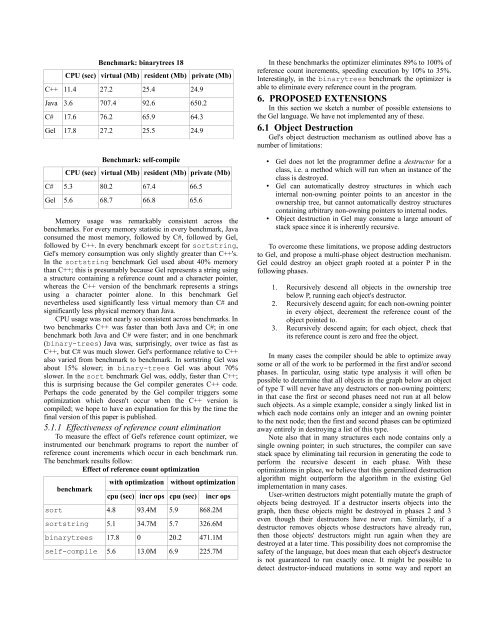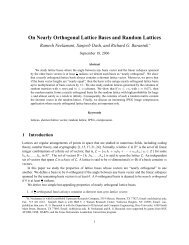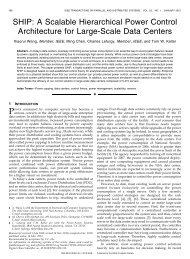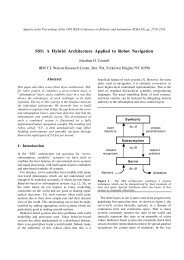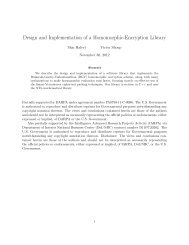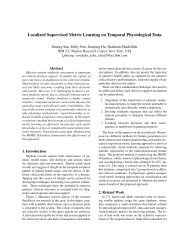Ownership You Can Count On: A Hybrid Approach - Researcher - IBM
Ownership You Can Count On: A Hybrid Approach - Researcher - IBM
Ownership You Can Count On: A Hybrid Approach - Researcher - IBM
You also want an ePaper? Increase the reach of your titles
YUMPU automatically turns print PDFs into web optimized ePapers that Google loves.
Benchmark: binarytrees 18<br />
CPU (sec) virtual (Mb) resident (Mb) private (Mb)<br />
C++ 11.4 27.2 25.4 24.9<br />
Java 3.6 707.4 92.6 650.2<br />
C# 17.6 76.2 65.9 64.3<br />
Gel 17.8 27.2 25.5 24.9<br />
Benchmark: self-compile<br />
CPU (sec) virtual (Mb) resident (Mb) private (Mb)<br />
C# 5.3 80.2 67.4 66.5<br />
Gel 5.6 68.7 66.8 65.6<br />
Memory usage was remarkably consistent across the<br />
benchmarks. For every memory statistic in every benchmark, Java<br />
consumed the most memory, followed by C#, followed by Gel,<br />
followed by C++. In every benchmark except for sortstring,<br />
Gel's memory consumption was only slightly greater than C++'s.<br />
In the sortstring benchmark Gel used about 40% memory<br />
than C++; this is presumably because Gel represents a string using<br />
a structure containing a reference count and a character pointer,<br />
whereas the C++ version of the benchmark represents a strings<br />
using a character pointer alone. In this benchmark Gel<br />
nevertheless used significantly less virtual memory than C# and<br />
significantly less physical memory than Java.<br />
CPU usage was not nearly so consistent across benchmarks. In<br />
two benchmarks C++ was faster than both Java and C#; in one<br />
benchmark both Java and C# were faster; and in one benchmark<br />
(binary-trees) Java was, surprisingly, over twice as fast as<br />
C++, but C# was much slower. Gel's performance relative to C++<br />
also varied from benchmark to benchmark. In sortstring Gel was<br />
about 15% slower; in binary-trees Gel was about 70%<br />
slower. In the sort benchmark Gel was, oddly, faster than C++;<br />
this is surprising because the Gel compiler generates C++ code.<br />
Perhaps the code generated by the Gel compiler triggers some<br />
optimization which doesn't occur when the C++ version is<br />
compiled; we hope to have an explanation for this by the time the<br />
final version of this paper is published.<br />
5.1.1 Effectiveness of reference count elimination<br />
To measure the effect of Gel's reference count optimizer, we<br />
instrumented our benchmark programs to report the number of<br />
reference count increments which occur in each benchmark run.<br />
The benchmark results follow:<br />
Effect of reference count optimization<br />
benchmark<br />
with optimization<br />
cpu (sec) incr ops cpu (sec)<br />
without optimization<br />
incr ops<br />
sort 4.8 93.4M 5.9 868.2M<br />
sortstring 5.1 34.7M 5.7 326.6M<br />
binarytrees 17.8 0 20.2 471.1M<br />
self-compile 5.6 13.0M 6.9 225.7M<br />
In these benchmarks the optimizer eliminates 89% to 100% of<br />
reference count increments, speeding execution by 10% to 35%.<br />
Interestingly, in the binarytrees benchmark the optimizer is<br />
able to eliminate every reference count in the program.<br />
6. PROPOSED EXTENSIONS<br />
In this section we sketch a number of possible extensions to<br />
the Gel language. We have not implemented any of these.<br />
6.1 Object Destruction<br />
Gel's object destruction mechanism as outlined above has a<br />
number of limitations:<br />
• Gel does not let the programmer define a destructor for a<br />
class, i.e. a method which will run when an instance of the<br />
class is destroyed.<br />
• Gel can automatically destroy structures in which each<br />
internal non-owning pointer points to an ancestor in the<br />
ownership tree, but cannot automatically destroy structures<br />
containing arbitrary non-owning pointers to internal nodes.<br />
• Object destruction in Gel may consume a large amount of<br />
stack space since it is inherently recursive.<br />
To overcome these limitations, we propose adding destructors<br />
to Gel, and propose a multi-phase object destruction mechanism.<br />
Gel could destroy an object graph rooted at a pointer P in the<br />
following phases.<br />
1. Recursively descend all objects in the ownership tree<br />
below P, running each object's destructor.<br />
2. Recursively descend again; for each non-owning pointer<br />
in every object, decrement the reference count of the<br />
object pointed to.<br />
3. Recursively descend again; for each object, check that<br />
its reference count is zero and free the object.<br />
In many cases the compiler should be able to optimize away<br />
some or all of the work to be performed in the first and/or second<br />
phases. In particular, using static type analysis it will often be<br />
possible to determine that all objects in the graph below an object<br />
of type T will never have any destructors or non-owning pointers;<br />
in that case the first or second phases need not run at all below<br />
such objects. As a simple example, consider a singly linked list in<br />
which each node contains only an integer and an owning pointer<br />
to the next node; then the first and second phases can be optimized<br />
away entirely in destroying a list of this type.<br />
Note also that in many structures each node contains only a<br />
single owning pointer; in such structures, the compiler can save<br />
stack space by eliminating tail recursion in generating the code to<br />
perform the recursive descent in each phase. With these<br />
optimizations in place, we believe that this generalized destruction<br />
algorithm might outperform the algorithm in the existing Gel<br />
implementation in many cases.<br />
User-written destructors might potentially mutate the graph of<br />
objects being destroyed. If a destructor inserts objects into the<br />
graph, then these objects might be destroyed in phases 2 and 3<br />
even though their destructors have never run. Similarly, if a<br />
destructor removes objects whose destructors have already run,<br />
then those objects' destructors might run again when they are<br />
destroyed at a later time. This possibility does not compromise the<br />
safety of the language, but does mean that each object's destructor<br />
is not guaranteed to run exactly once. It might be possible to<br />
detect destructor-induced mutations in some way and report an


